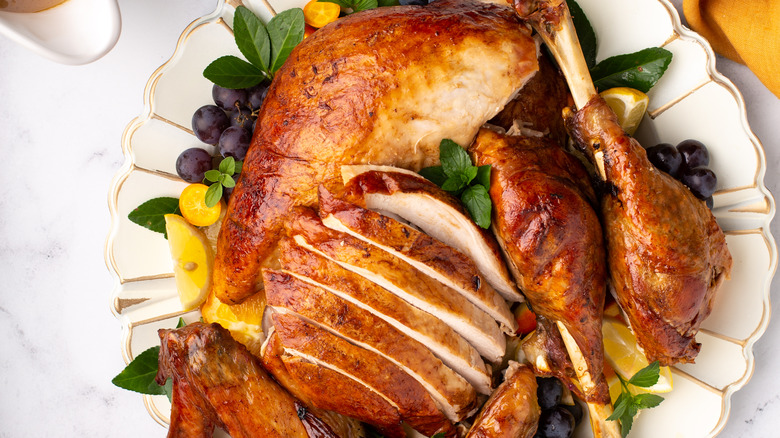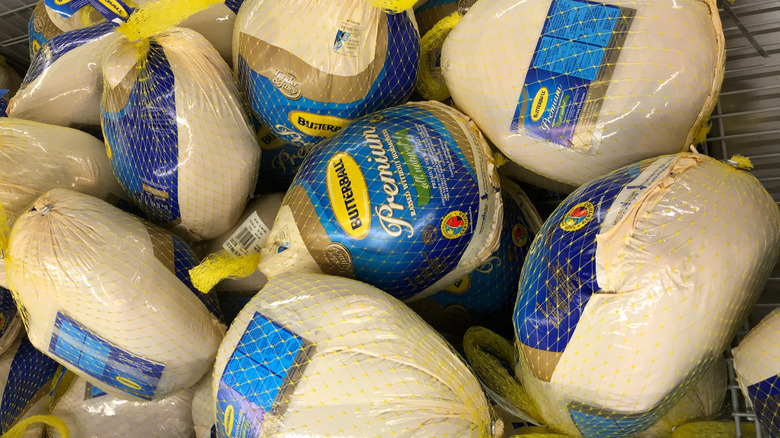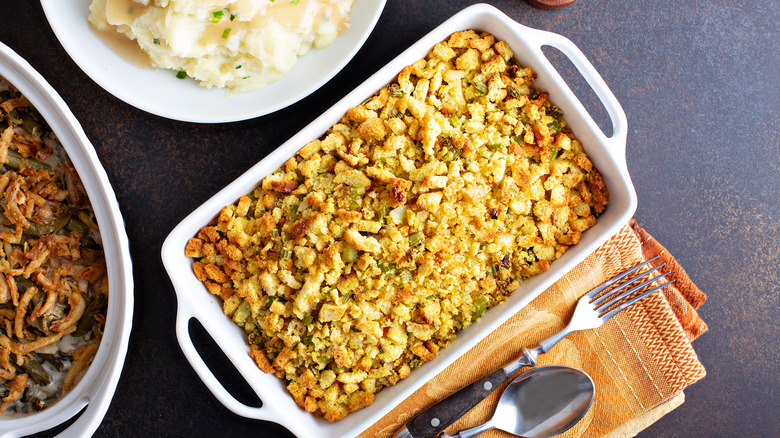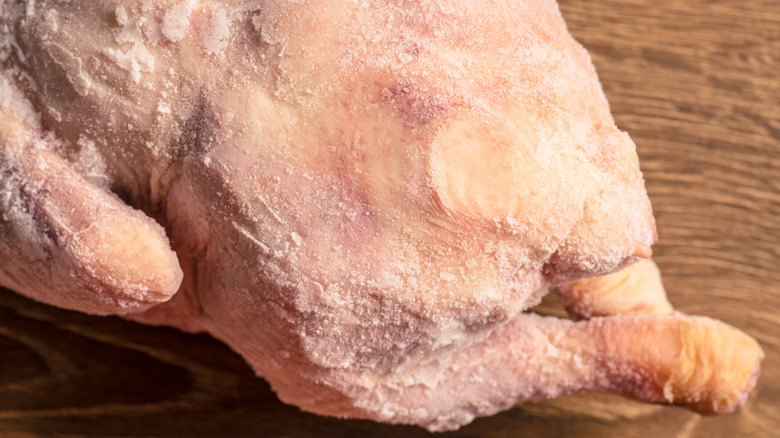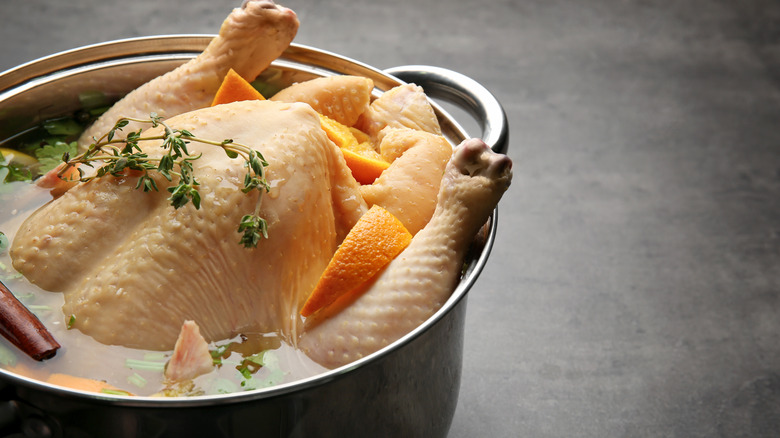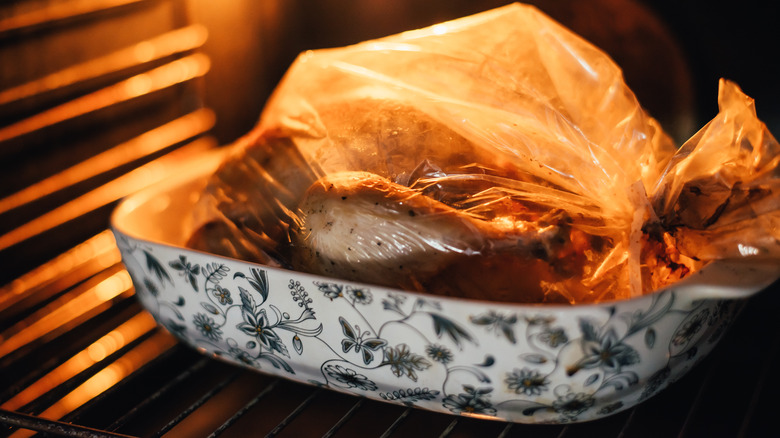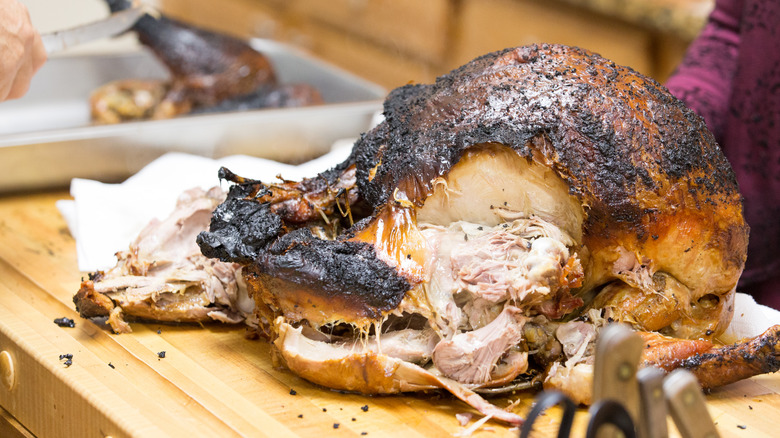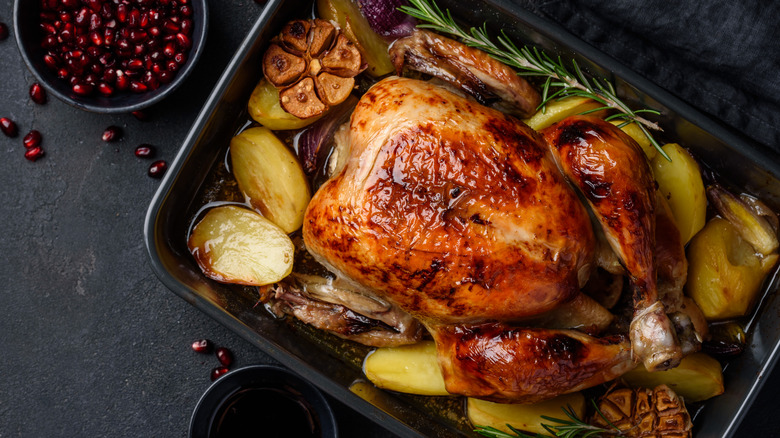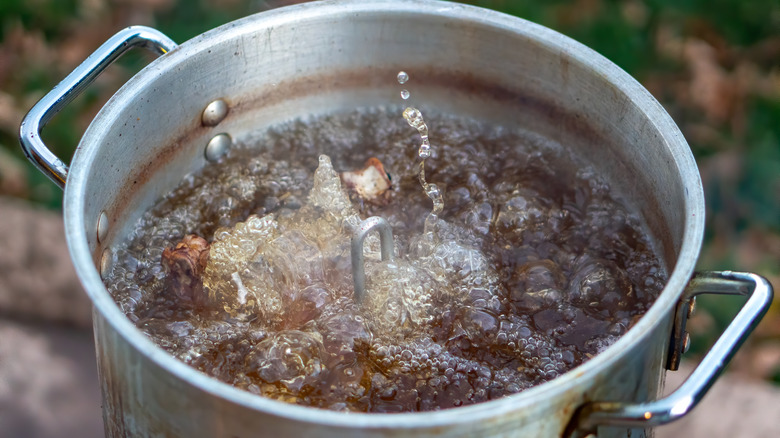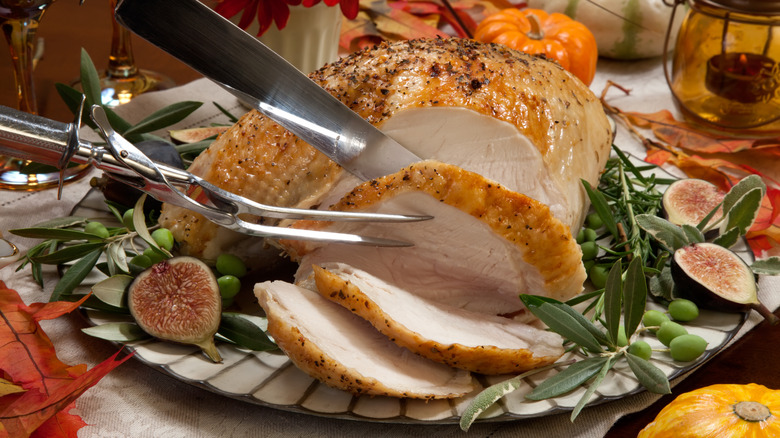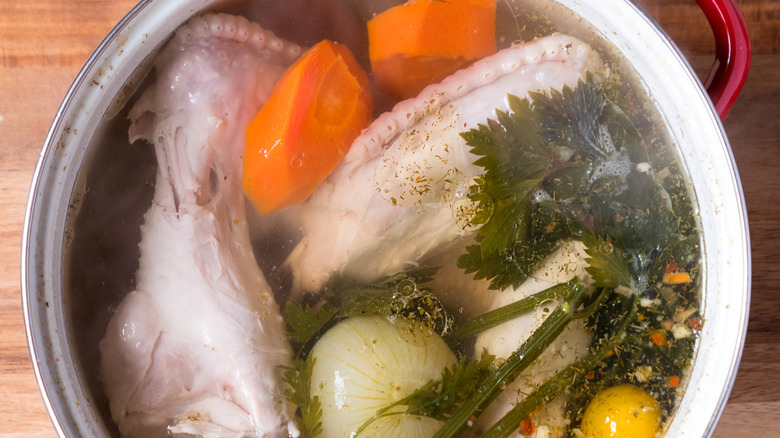The 11 Biggest Mistakes Everyone Makes With Turkey
Hate it or love it, you're probably eating turkey for Thanksgiving. Amidst an incessant cycle of food and diet trends, serving turkey on Thanksgiving is a tradition that seems to be cemented into the menus of our minds. While you might be whipping up baked feta pasta instead of mac and cheese or adding a fancy butter board to your usual appetizer spread, we'd bet you haven't thought twice about what your entrée will be.
Though most people schedule their entire holiday around cooking whole turkeys, doing so isn't necessarily something people often do. Whether it's an unknown error that's been passed down for generations or a simple first-timers' mishap, mistake-making on Thanksgiving is just as predictable as the turkey itself.
Of course, if you're a culinary expert like chef Harold Moore, you know a thing or two about how to make the best bird on the block. The celebrated, innovative chief culinary officer of New York City's highly-esteemed Charlie Palmer Steak has shared his turkey-making advice with us to help the everyday citizen kick their Thanksgiving know-how up a notch. From foundational basics to coveted tips only an expert would know, here's how to maneuver around common mistakes and master the art of turkey preparation.
1. Buying a low-quality bird
Don't think twice about serving turkey for Thanksgiving, but do think twice about which turkey you'll serve.
Chef Moore recommends purchasing an "organic, free-range turkey from a farm that you know." The culinary professional is based in New York City, where the farms are far and few between subways and skyscrapers. In other words: if you want to serve an impressive bird, you might have to venture further than your local grocery store. Buying name-brand turkeys makes it difficult to confirm exactly what's in them since they're often filled with additives or antibiotics.
While you don't necessarily have to hike to the nearest farm, you should try to choose a bird whose natural flavors are unpolluted. Chef Moore puts it plainly: "I do not like a big, boxed [turkey] that come[s] pre-brined, injected with garbage." Though "garbage" is a hyperbolic term here, many store-bought birds are pre-brined with an unknown concoction of ingredients.
Butterball, for example, provides this vague list of ingredients on its website for its pre-brined turkeys: "Up to 4% of a solution of water, salt, and spices to enhance tenderness and juiciness." Plus, since the bird is sold by weight, you might end up paying for a whole lot of saltwater rather than actual meat. As far as antibiotics go, Consumer Reports notes that consuming antibiotic-raised turkeys can potentially lead to food-borne illness. Finally, it's always better knowing the animal you're eating wasn't subjected to inhumane practices.
2. Stuffing the turkey
If the turkey is first on the list of Thanksgiving traditions, stuffing is a close second. For many, it's also a dish primarily saved for this holiday; as such, it's not one everyone knows how to prepare. In accordance with its self-evident title, stuffing is commonly cooked inside the turkey. In fact, its suspected inventor, a first-century Roman gourmand, was known for inserting all kinds of ingredients into all kinds of animals, as per The Wall Street Journal.
The bread-based mixture often includes various herbs and vegetables but is by no means only cookable inside the cavity of a turkey. This practice is likely a centuries-old custom perpetuated for the sake of, well, custom. While tradition is good and well, we're here to say that stuffing your turkey is not. Chef Moore affirms that putting it inside the turkey cavity isn't ideal for a well-cooked bird, pointing out that "once the stuffing [is] warm, the turkey is overcooked." Of course, taking the bird out mid-roast to remove the done interior would be even worse, so it's best to find a dressing recipe you love and prepare it separately from your main course.
3. Cooking the turkey while it's still cold
Many people start planning their Thanksgiving menus and cooking schedules up to a month in advance. And, since turkey is such a hot commodity in November, people often purchase their birds days or even weeks before the holiday. Freezing the turkey is fine, but only if you know how to thaw it properly.
Many people don't realize that they're putting a still-cold bird in the oven, which will seriously affect how long and evenly the turkey is cooked. A frozen bird can take several days to defrost, and Chef Moore emphasizes the importance of making sure that your turkey is "completely thawed." Not only should the bird be fully defrosted, but it should also actually be close to room temperature when it's time to roast it. Chef Moore explains that you should "temper" the turkey before it's put into the oven, taking it out of the refrigerator about an hour before it cooks to "ensure it cooks evenly."
4. Wet-brining
To brine or not to brine? Bring it up in a room full of chefs, and you'll likely start a salty debate. On Thanksgiving, people brine turkeys by submerging them in a saltwater solution for hours before cooking. Preparing meat this way is thought to enhance its ability to stay moist as it cooks.
However, while wet-brining isn't necessarily bad, it opens the door for the easy-to-be-made mistake of putting the turkey in the oven while it's still wet. Doing so will ruin your chances of enjoying a turkey with golden, crispy skin. Plus, wet brining can be kind of messy — picture a huge vat of salty water sloshing around your already-haphazard kitchen on Thanksgiving.
Though wet-brining a turkey is usually a step earnestly taken towards making juicy and moist meat, Chef Moore asserts that it isn't necessary because "good cooking techniques help deliver that same moistness."
One of the "good cooking techniques" we'd suggest is using a dry brine — coat your turkey in plenty of salt and the herbs of your choosing and let it sit that way for hours or even days. Chef Moore notes that, when wet-brined, the turkey's natural flavor is often overpowered by that of the brine. The dry brine technique combats this issue: Rather than sweating out the watery, leftover brine, the bird will sort of self-marinate as its natural, flavor-packed juices begin to excrete as it cooks. You'll also enjoy crispier, seasoned skin with this method.
5. Covering the turkey in the oven
The hardest part about cooking turkeys — especially larger ones — is retaining a moist, juicy interior while ensuring that the outside is browned and the entire animal is cooked evenly. It's common to be left with a bird that's perfect in some parts but super dry elsewhere or one with immaculately crispy golden skin but a horribly overcooked interior.
Savvy home chefs have thought up inventive methods for helping their turkeys stay moist, like roasting bags. While cooking, covering the turkey with an oven bag or foil can help the meat retain moisture. However, Chef Moore notes that covering the bird while it's in the oven will create a steaming effect that, while great for juicy meat, isn't so helpful if you want to enjoy the satisfying bite of golden, crackling skin.
If you're hoping to favor culinary integrity over convenience, he suggests roasting the turkey slowly at a low temperature for the optimal combo of tender meat and crispy exterior. However, not all ovens (or birds) are created equally. Keep an eye on your turkey while it's cooking, and if the skin starts to look pretty perfect before it's ready to come out, you might want to loosely tent some tin foil over the top. Do so only if necessary because opening the oven frequently will seriously affect its internal temperature.
6. Cooking at too high of a temperature
For those who host, Thanksgiving can be one hectic holiday. Between cleaning, setting up decorations, placing settings, and preparing appetizers, sides, desserts, and drinks, you probably wind up running around like a headless chicken (ahem, turkey). When you're so busy, you might want to find the most efficient way to do everything, but when it comes to serving a great turkey, patience is key.
Chef Moore is adamant: "Cook it low and slow." The slower, the better, and you can even leave the bird in the oven overnight if you've got a particularly large one. According to Williams Sonoma Taste, you can cook it for about nine to ten hours at around 200 degrees.
If overnight preparation isn't your favorite idea, you can start with a higher temperature of about 400 degrees, roast the turkey for about 45 minutes, and then let it cook at a lower temperature of about 300 degrees for an hour or so, depending on its size. Aside from deep-frying, there's no real fast-cook option when it comes to preparing this bird, no matter how high of a temperature you use. Again, the lower and slower, the better, so make do with the time you've got!
7. Neglecting your thermometer
Many Thanksgiving turkeys come pre-prepared with a pop-up thermometer inside of them. Convenient, right? Wrong! These temperature-measuring methods are generally unreliable or inaccurate, according to many experts.
While you shouldn't refer to these pre-installed thermometers, you should still be using a thermometer to check your bird's internal temperature. The USDA says that turkey must be cooked to an internal temperature of 165 degrees to be safe for consumption, and this is also the temperature you want to reach for optimally juicy and tender meat. Opt for an oven-safe thermometer that you can leave in the bird while it cooks. This way, you won't have to constantly open the oven to check on it.
However, while checking your turkey's temperature is important, Chef Moore doesn't suggest you keep your eye on the number 165. "Only cook the turkey to 150 degrees, then pull it out and rest it up to 165 degrees," he suggests. He further notes that the residual heat will carry over another 12 to 15 degrees even out of the oven. Removing the bird from the oven at 150 degrees helps ensure that it stays moist and doesn't overcook. Of course, you should still double-check your thermometer before carving.
8. Forgetting a roasting rack
There might be a million and one ways to prepare a turkey, but most of these methods are about optimizing how evenly the meat cooks. If you're using an oven to roast your bird, it's extremely important to remember that there's a convection effect.
To ensure that heat is circulating all around and throughout the turkey evenly, it cannot be placed flat on a pan. This is where roasting racks come in — they're raised over the bottom of a large pan for the meat to rest on. This way, air flows evenly, and any drippings are caught in the pan. Don't have a roasting rack? Don't head to the store just yet.
Chef Moore says he prefers to cook his bird on a bed of veggies like carrots, celery, and onions. Roasting the turkey atop a bed of vegetables is also a great method because, during this process, the bird and the vegetables add flavor to each other. The veggies add an aromatic depth to the turkey and its drippings, which Chef Moore likes to use as a gravy, and the savory, fatty juices from the meat make for some sumptuous veggies that can be used as an easy side dish.
9. Deep frying your turkey...indoors
If you've never deep-fried a turkey, you might only think of the practice associated with those viral videos of people setting themselves on fire or blowing something up in the process. While this can certainly be one of the more dangerous cooking methods (via Butterball), it makes for a super tasty bird if you do it right.
Chef Moore gives an appreciative nod to the deep-frying method, noting that it "makes for crispy skin, very moist meat, and fast cooking time!" According to Butterball, frying a turkey only takes about three to four minutes per pound. That's some seriously fast cooking time for Thanksgiving, but it won't feel so efficient if you wind up spending half the day in the emergency room. Take our and Chef Moore's advice: "If you're [going to] deep fry the turkey, make sure you're doing it outside — not in the garage, not under a roof!"
10. Carving incorrectly
You've done it! You purchased a quality turkey, brined it, thawed it, and did everything to ensure it's been cooked to perfection. Now, it's time to serve.
When you're sure that your bird has reached a safe temperature for eating, the first thing you'll want to do is wait. Chef Moore says it's important to let the meat rest for about 10 to 15 minutes before you dig in with your knives — all of which, he insists, should be sharpened the week before Thanksgiving. A dull blade will leave you with uneven, unappealing cuts, torn turkey skin, and a whole lot of frustration.
Now, how to carve? It's easy to start by removing the legs via the thigh bones. Chef Moore likes to take out the thigh bones but serves the drumsticks whole — optimal for "eating them like an animal," as he suggests. Next, he says it's easiest to "remove the breast from the carcass and slice it on a cutting board," which, again, should only be done with a nicely-sharpened carving knife. Use tongs to hold the meat in place while you slice for safety and to help create nice, even cuts.
11. Tossing your scraps
When you cook a whole turkey, there are bound to be leftovers. While you probably have some long-time favorite Thanksgiving leftover recipes for the meat, you may not have considered that there are plenty of uses for the other leftovers — the giblets.
Turkey giblets are organs like the liver, heart, kidneys, neck, or gizzards that typically come neatly packaged inside the bird when you buy it. Don't let these oddly-shaped meaty bits scare you off. They're packed with nutrients and flavor and are often used to make a hearty, turkey-flavored gravy for the occasion. Chef Moore notes that some cooks choose to "chop and fold them into the stuffing" as well.
If you've already perfected your gravy and dressing recipes sans giblets, take Chef Moore's route: "I usually sauté [the giblets] on the side and feed the crowd I'm cooking for while I finish up." Simmered in butter and herbs, these savory bites make for a refined yet on-theme amuse-bouche.
Your Thanksgiving trash can might be swallowing up some other valuable turkey scraps: the bones. You've probably kept the wishbone, but Chef Moore urges you never to throw away any of the bird's bones. They are made up of cartilage filled with a wealth of flavor you won't find elsewhere. Chef Moore suggests saving them to make a classic turkey carcass soup. Letting the bones simmer for long periods helps break down the cartilage, infusing your soup with a rich, fatty, and meaty flavor.
